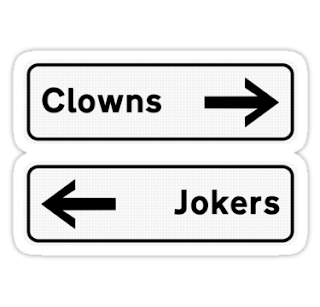Planning Part V: Manufacturer/Supply Partner Relationships
 |
| Ever feel like you're wearing this t-shirt? |
Manufacturer/Supply Partner Relationships
Stuck in the Middle with You
A quick blast from the past: its 1972, you’re tooling
down the road in your dad’s Oldsmobile grooving on Casey Kasem’s American Top
40 Countdown. As you navigate your way
through the A&W parking lot, Casey spins the song soon to be the theme of
distributors everywhere, “Stuck in the middle with you”. And, just like the song says, we in the
distributor world are stuck in the middle with our suppliers. This means supply
partner planning is every bit as important as customer planning. And keeping with the lyrics, you may find you're dealing with both clowns and jokers along the way. Discovering and handling these will contribute to your success in the coming year.
Supplier Stratification
As with customers, the first step in building a plan (and
a strategy) comes in understanding the positioning of your suppliers. I call this supplier stratification. Fundamentally all suppliers fall into one of
6 categories:
1. Profit Partners – these are the
suppliers who account for day to day profits.
They work closely with your team to grow business today and provide the
revenue flow that supports your business.
2. Strategic for immediate growth – these
are suppliers that allow you to produce growth and revenue next year. Often these are product lines on the
periphery of your current sales. For
example, an electrical distributor might produce immediate growth by working
with a vendor of electrical safety equipment.
Just a little attention today could produce growth without a great deal
of training and positioning. These will
never make your top 10 suppliers, but adding a couple hundred thousand to the
top line sale is not a bad thing. (By
the way, I recommend setting a minimum growth amount to make this list. This varies from company to company but $100K
in two years is a good starting point.)
3. Strategic for long term growth – these
are accounts which drive your company into the future. They stand in place to be major producers
sometime in the next 5 years. As our
world changes these manufactures are emerging technologies which position your
company over the longer haul.
4. Customers want them so we keep them around
– suppliers that you would like to convert their sales to something else but
customers keep asking for the brand.
Some manufacturers have strong brands but employee saturation
distribution. They bring little
strategic value to your company, the margins may be low, and they do little to
improve your place in the market.
5. Line fillers – we all have them. We take orders for their products but don’t
really proactively sell their products.
6. Don’t know why we have them – do little
for us and occupy a small place in our catalog and on our shelves. We probably would have severed ties but just
haven’t gotten around to it.
Understanding the profit picture involves
more than just Gross Margin percentage…
Many distributors make the mistake of evaluating their
suppliers on gross margin alone. But the
top performers have developed more comprehensive methods for scoring their
vendors. Things like ease of doing
routine business, “pull through” of other products, ability to support your
efforts and aggressive distributor friendly marketing plans must be taken into
consideration.
If you have not already developed a supplier scorecard,
you should make this a top priority.
Stay tuned, because we will soon be making our own scorecard available…
Supplier planning is critical
We don’t have time to plan with everyone. But armed with your new stratified vendor
list, it should be obvious who deserves your time and effort. Your plans should
include joint marketing activities, focused training, and expanded product
launches. It should also include some
very specific product targeting.
Any plans should include dates, responsibilities, and
desired measures of success. Dates for
some kind of formal plan review must be a part of a real working plan.
If the vendor doesn’t want to join you in real action
oriented planning, if they don’t want to carry the burden of their portion of
the activities, or if their local team refuses to engage, now is the time to
reevaluate their position in your stratified list of supply partners.
Does your sales team know the status of the
suppliers?
Strange as it may see, many distributors struggle because
their sales team doesn’t know the status of suppliers. Sometimes they do know but refuse to follow
management direction because of personality conflicts with the local team of
your best suppliers.
End of the year planning includes spending time
explaining the importance of a unified push into the market. Some of your “lone ranger” sales types may
need more than a pep talk. I recommend
scheduling follow-up meetings on a quarterly basis to insure your market
direction is followed.
There a quite a few more points for the more advanced
distributor (we will be publishing a more complete document soon), but armed
with this short list you’re on your way to a great end of the year plan.
Distributor Planning Made Easy. Check out our Distributors Annual Planning
Workbook:
http://tinyurl.com/DistributorAnnualPlanning


Comments